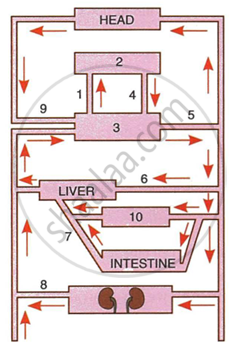Advertisements
Advertisements
Question
Given below is the simplified pathway of the circulatory system:
(i) Name the blood vessels marked 1 to 8.
(ii) Name the chamber of the heart which:
(a) Receives blood from ‘1’.
(b) Pumps blood into blood vessel ‘8’.
(iii) Mention two structural differences between blood vessels ‘7’ and ‘2’.
Solution
(i)
1. Pulmonary vein
2. Dorsal aorta,
3. Hepatic portal vein
4. Renal artery
5. Iliac vein
6. Hepatic vein
7. Inferior vena-cava
8. Pulmonary artery.
(ii) (a) Left auricle.
(b) Right ventricle.
(iii) (a) The inferior vena cava arises from iliac veins coming from the hind limbs, while the dorsal aorta arises from the left ventricle and continues behind as the abdominal aorta.
(b) The deoxygenated blood is collected by the inferior vena cava, while the branches of the dorsal aorta supply oxygenated blood to the body parts.
APPEARS IN
RELATED QUESTIONS
Given below is a certain structure, write its chief functional activity.
Erythrocytes - ______.
How do you account for the following difference?
The left ventricle has thicker walls than the right ventricle.
How do you account for the following difference?
The walls of the right ventricle are thicker than those of the right auricle.
Given below is a highly schematic diagram of the human blood circulatory system.
 |
- Which part (state the number) represents the heart? Give reason in support of your answer.
- Which numbers represent the following, respectively?
Aorta Superior vena cava Hepatic portal vein Renal Vein Pulmonary artery Stomach
Blood consists of two parts - a liquid part and a cellular part. Name these parts and briefly write about them
The oxygen-rich blood from the lungs comes into the ______ of the heart.
Name the organ from which oxygenated blood goes into the heart
The table below is designed to indicate the transport of certain substances in our body. Fill in the blanks with suitable answers.
| Substance | From | To | |
| 1. | ______ | Lungs | Whole Body |
| 2. | Carbon Dioxide | ______ | ______ |
| 3. | Urea | ______ | ______ |
| 4. | Digested Carbohydrates | Intestines | ______ |
| 5. | ______ | ______ | Target Organs |
| 6. | Heat | ______ | Whole Body |
The artificial method of filtering the blood or removing the wastes from the blood.
Serum differs from blood in lacking ____________.
